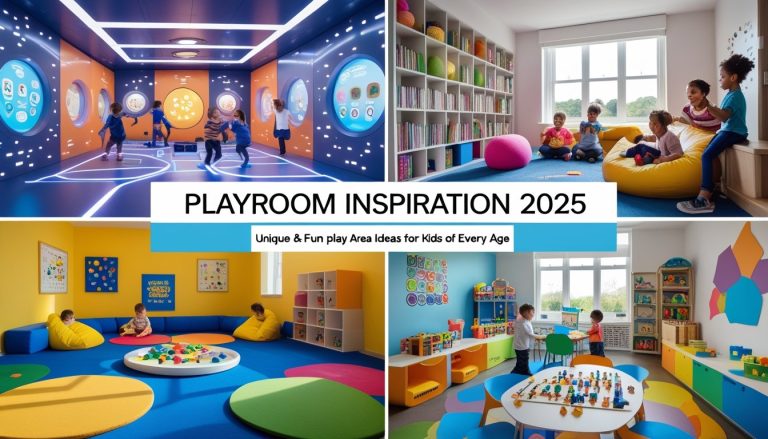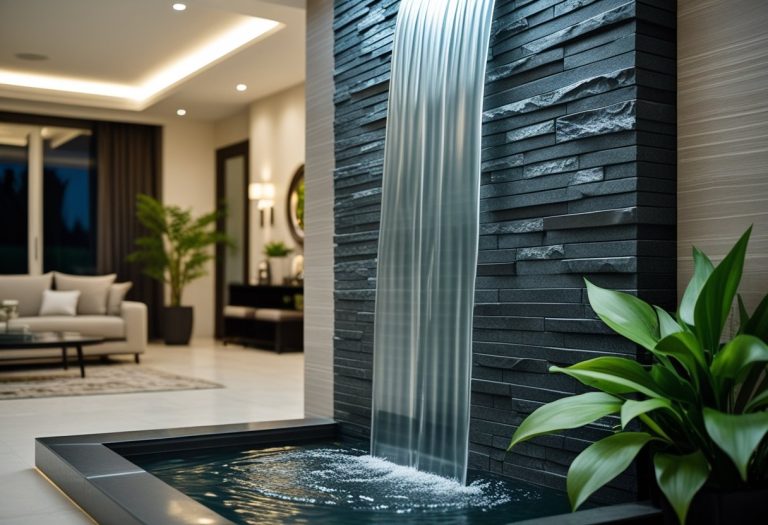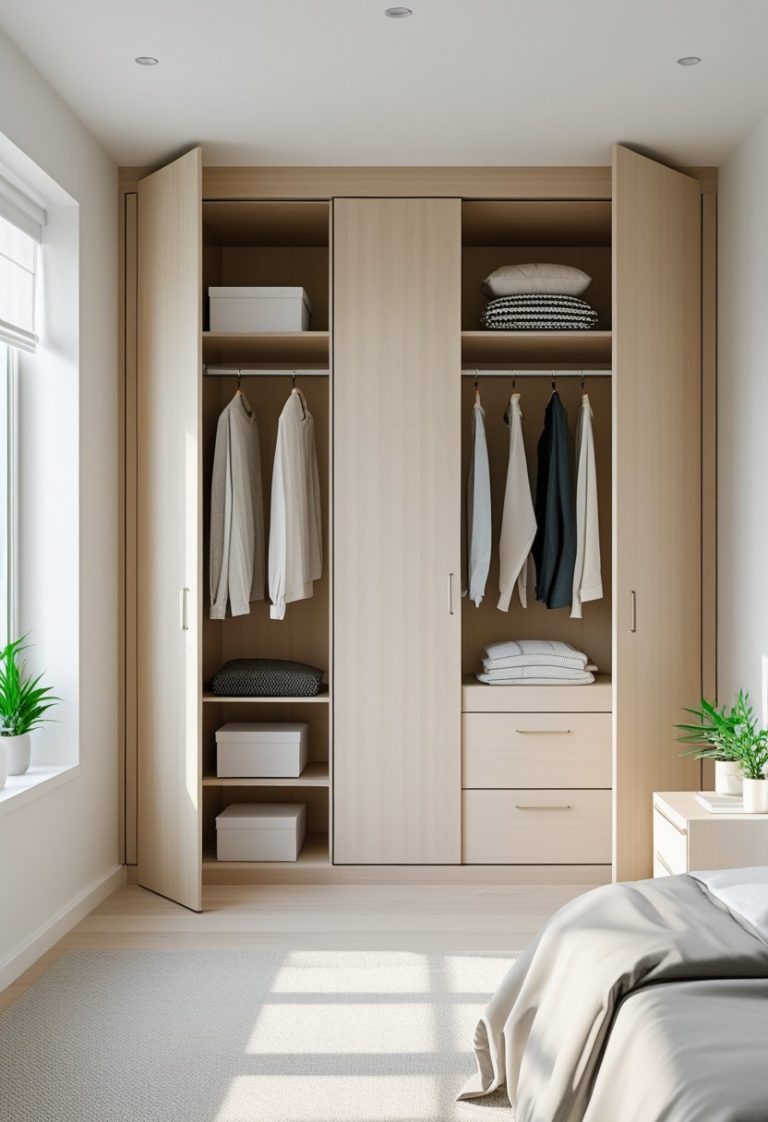Cozy Minimalist Wall Shelf Decor Trends for Modern Homes
Transforming a home into a cozy, modern sanctuary can be simple with the right minimalist wall shelf decor. This design blends warm wooden textures, golden lighting, and lush indoor plants with clean white floating shelves to create a balanced and inviting space. It fits perfectly in small apartments or rented spaces where maximizing style without clutter is essential.
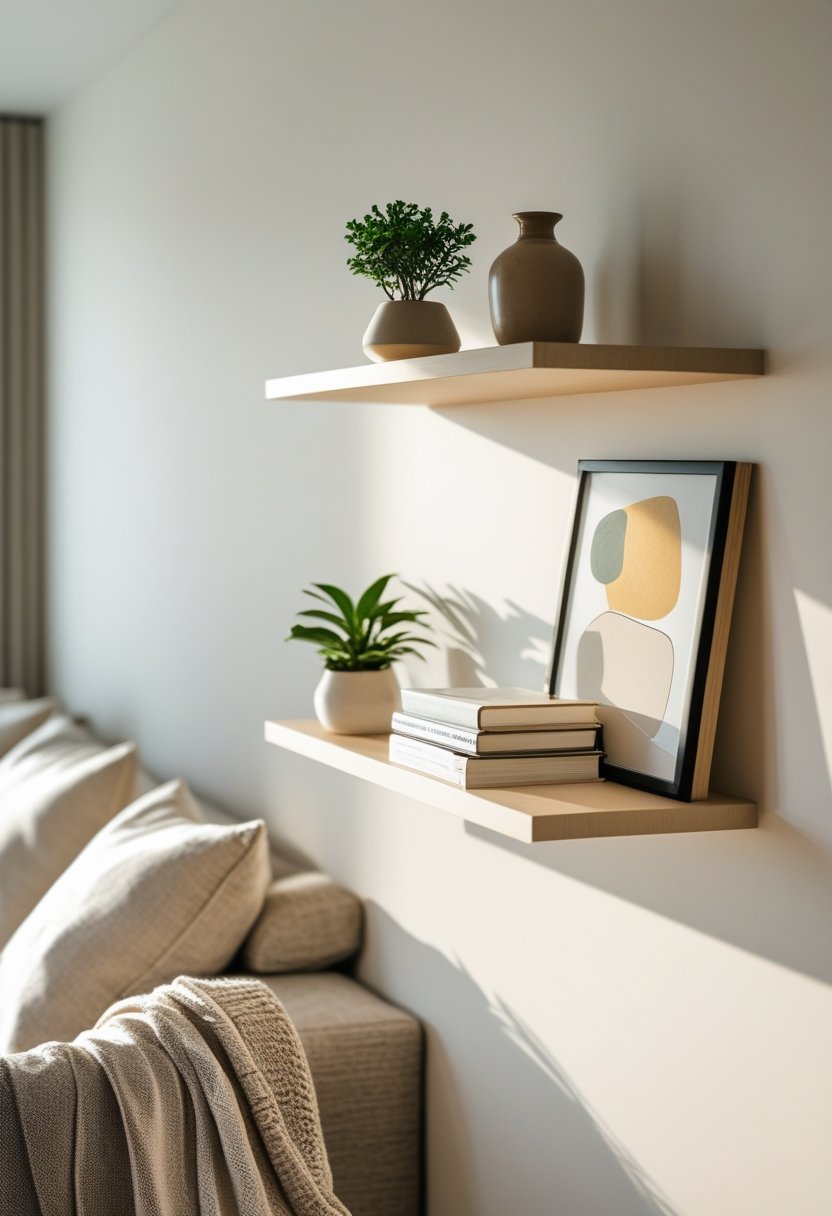
By combining Scandinavian simplicity with biophilic design, this idea captures 2025’s key decor trends, offering a calm, nature-inspired vibe that feels both fresh and timeless. Adding potted greenery and soft lighting enhances the cozy minimalist look while keeping the space budget-friendly and versatile for all seasons.
This approach encourages intentional living through thoughtful choices that emphasize texture, light, and natural elements. It allows anyone to create a personalized, stylish corner that feels open yet warm, proving minimalist decor can be both functional and welcoming.
Foundations of Cozy Minimalist Wall Shelf Decor

Creating a cozy minimalist wall shelf design requires attention to natural elements, balanced color palettes, and a mix of textures. Thoughtful integration of materials and design principles fosters calmness while maintaining modern aesthetics. This approach prioritizes function and warmth without clutter.
Embracing Warm Wooden Textures
Warm wooden textures are vital in bringing natural materials into minimalist decor. Wood adds depth and organic warmth to spaces that might otherwise feel stark or impersonal. Opting for lighter woods like oak or ash aligns well with neutral tones and Scandinavian influences.
Wood grain introduces subtle variation without overwhelming, enhancing cozy minimalism. These textures work well on shelf surfaces or frame accents, complementing indoor plants and soft lighting. The tactile quality of wood encourages a natural, lived-in atmosphere while remaining simple and refined.
Blending Scandinavian Simplicity With Biophilic Design
The blend of Scandinavian simplicity and biophilic design focuses on clean lines paired with natural elements. Scandinavian style emphasizes minimalism through functional shapes, minimal clutter, and a restrained color palette dominated by whites, greys, and soft neutrals.
Biophilic design adds lush greenery and natural forms, connecting interiors with nature. Incorporating potted plants on shelves enhances air quality and injects life into minimalist spaces. This fusion creates a calming environment that supports well-being while maintaining sleek, modern home design ideas.
Clean White Floating Shelves as a Canvas
Clean white floating shelves serve as a neutral backdrop, allowing natural materials and decor accents to stand out. Their simplistic form supports a minimalist home aesthetic by reducing visual bulk and providing flexible display space.
These shelves suit small apartments or rented spaces due to easy installation and versatility. White shelving enhances light reflection, contributing to an airy atmosphere. Paired with warm wooden textures and greenery, the white surfaces highlight contrast while keeping the color palette balanced and soothing.
Creating Atmosphere With Lighting and Neutral Tones

Lighting and color choices define the mood and perceived space of a room. Warm, layered lighting paired with thoughtfully selected neutral tones can soften edges and invite a sense of calm and comfort. Careful attention to these elements enhances minimalist design, creating an environment that feels both modern and inviting.
Soft and Ambient Lighting Techniques
Soft, ambient lighting provides a gentle glow that prevents harsh shadows and glare. Using multiple light sources like floor lamps, table lamps, or wall sconces helps distribute warmth evenly throughout the space. Adjustable dimmers are valuable tools for tailoring brightness to different times of day or moods.
Layering light sources adds depth and highlights textures, especially on wooden surfaces or textured wall shelves. LED bulbs with a color temperature between 2700K and 3000K offer a warm light that keeps the room cozy without overpowering its minimalist aesthetic. Indirect lighting, such as hidden strips underneath shelves, enhances ambient luminance subtly.
Utilizing Golden Accents for Warmth
Golden lighting fixtures or accent pieces introduce warmth that contrasts with cool neutrals, making the room feel welcoming. Brass or gold-toned lamps, frames, and shelf brackets reflect light and add subtle luxury without disrupting the minimalist design.
Incorporating golden elements strategically around the shelves creates focal points, drawing the eye and breaking monotony in neutral palettes. Soft, warm-colored LED bulbs complement these accents by emitting light that accentuates gold’s richness without causing harsh reflections.
Balancing Neutral Tones in Small Spaces
Neutral palettes are ideal for small spaces, as they maximize light reflection and maintain an open feel. Combining shades of white, beige, and soft gray with natural wood tones creates visual interest without clutter. The key is layering textures—such as matte ceramics, smooth wood, and soft textiles—to avoid flatness.
Contrast through darker neutrals on a plant pot or a shelf frame anchors the design while keeping the overall palette light. This balance helps visually expand small corners, making the minimalist shelf decor look intentional and soothing rather than sparse or sterile.
Showcasing Lush Greenery and Natural Elements

Incorporating plants and natural textures enhances the warmth and tranquility of minimalist spaces. Selecting the right greenery and arranging it thoughtfully contributes to both aesthetic appeal and the biophilic connection to nature. Proper plant care ensures longevity and success in small or rented homes.
Choosing the Right Indoor Plants
Selecting indoor plants that thrive in limited light and require minimal upkeep is essential for cozy, modern interiors. Snake plants stand out because they tolerate low light and infrequent watering, making them ideal for renters or those new to plant care.
Other good choices include pothos, philodendrons, and ZZ plants, all known for their resilience and air-purifying qualities. When choosing, consider the plant size relative to shelf or corner space to avoid overcrowding and maintain a clean look. Using pots in neutral tones or natural materials like clay or wood complements the minimalist, nature-inspired theme.
Integrating Greenery for Biophilic Appeal
Biophilic design involves connecting indoor environments with nature by integrating organic elements. Floating white shelves framed by warm wooden textures provide a perfect base for potted plants.
Combining varied leaf shapes and textures adds visual interest while maintaining simplicity. Incorporating golden lighting highlights plant features and creates a calming ambiance. Position plants where they receive indirect sunlight to sustain health without disrupting a minimalist aesthetic.
Using plant stands or hanging planters can add vertical dimension without cluttering surfaces. This approach supports a serene, nature-connected vibe essential in modern minimalism.
Caring for Snake Plants and Low-Maintenance Options
Snake plants require minimal care, making them a practical choice for small, stylish living spaces. They thrive in indirect light but tolerate shade well, needing watering only when the soil feels dry to the touch.
These succulents prefer well-draining soil and containers with drainage holes to prevent rot. Avoid overwatering, especially in cooler months, to prolong plant health.
Other low-maintenance plants follow similar care guidelines, reducing effort while supporting the lush, natural atmosphere central to modern home sanctuaries.
Functional and Stylish Storage Solutions

This design blends practicality with aesthetic appeal, offering multiple ways to organize without sacrificing style. It focuses on optimizing space through thoughtful storage choices that suit small areas and modern tastes.
Hidden Storage for Clutter-Free Spaces
Hidden storage techniques help maintain a clean, streamlined look by concealing everyday items. Furniture with built-in compartments or storage ottomans can hide clutter while serving dual purposes.
Containers with subtle designs, like woven baskets or drawers integrated into shelving units, keep essential items out of sight. This reduces visual noise, enhancing the minimalist vibe and making small rooms feel larger.
Labels and modular systems boost functionality in hidden storage. They keep belongings organized, simplifying access without disrupting the calm atmosphere of the space.
Open Shelving for Decorative Display
Open shelving offers a chance to combine storage and decoration effectively. Floating shelves in white or light wood provide surfaces for plants, books, and curated objects, adding personality while staying minimal.
It allows plants to create a natural touch, aligning with biophilic design. Items arranged with attention to balance and negative space enhance the room’s aesthetic and avoid overcrowding.
These shelves should be functional as well, ideal for frequently used items or decorative pieces that enhance warmth and texture.
Incorporating Built-In and Floating Shelving
Built-in shelving maximizes space and integrates seamlessly into walls, often custom-designed to fit the room’s dimensions. This prevents wasted space and creates a tailored look.
Floating shelves appear light and unobtrusive, supporting minimalism without bulk. They provide flexible storage options ideal for small areas or rented homes, as they can be mounted without large installations.
Both types can include compartments or decorative elements that tie into the warm wood and neutral tones of the overall design. Combining these shelving options maximizes organizational potential while maintaining a clean, modern appearance.
Selecting Functional Furniture and Soft Furnishings
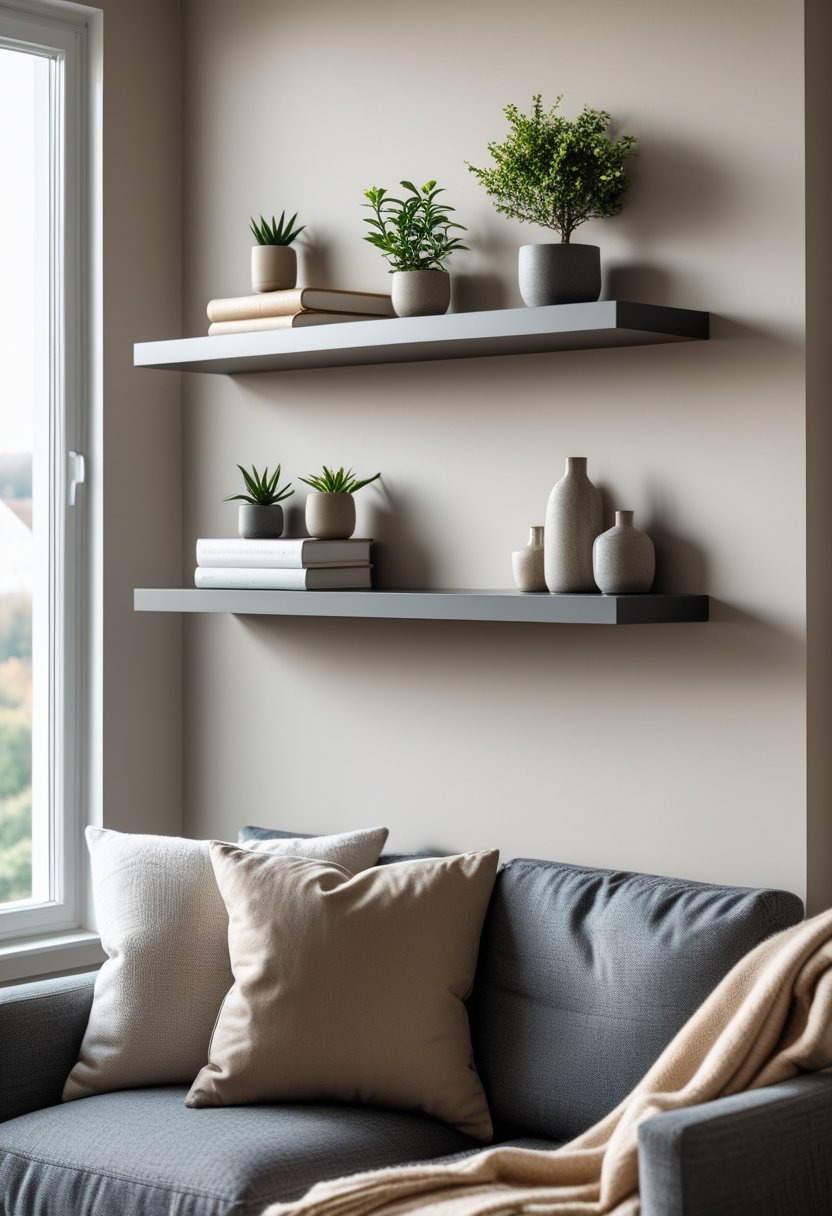
Choosing the right furniture and soft furnishings is essential to balance comfort, style, and practicality. Incorporating pieces that serve multiple purposes while enhancing the minimalist aesthetic helps maintain a clutter-free space. Attention to materials, textures, and usability ensures that every item contributes to a cozy, functional home environment.
Wooden Furniture That Marries Style and Utility
Wooden furniture brings warmth and natural texture, key elements in modern minimalist interiors. Opting for pieces with clean lines and subtle grain patterns emphasizes Scandinavian simplicity. Items like compact wooden desks or nesting tables provide essential storage and workspaces without overwhelming the room.
Durability is important, so solid hardwood or quality engineered wood should be prioritized. These materials resist wear better than particleboard or veneers. The natural look of wood also complements lush indoor plants and white floating shelves, creating a balanced design that feels inviting yet streamlined.
Prioritizing Quality Over Quantity
Focusing on a few well-crafted pieces avoids overcrowding and supports a minimalist lifestyle. Quality furniture offers longevity, reducing the need for frequent replacements. This approach promotes sustainability and helps manage a limited layout, especially in rented or small apartments.
Heavier or bulkier items should be avoided in favor of versatile, lightweight designs that are easy to rearrange. Multi-functional furniture such as storage benches or foldable chairs maximizes usability. This careful selection maintains the room’s airy atmosphere while delivering practical benefits.
Choosing Cozy Soft Furnishings
Soft furnishings add tactile comfort and warmth that hard furniture alone cannot provide. Layered textiles like wool throws, linen cushions, and natural fiber rugs complement minimalist furnishings by adding subtle texture without visual clutter.
Neutral color palettes, including off-whites, beiges, and soft grays, enhance the calming effect. Prioritize materials that feel pleasant against the skin and maintain durability, such as cotton blends or sustainably sourced wool. These options support a cozy ambiance while reinforcing the clean, airy look central to modern minimalist interiors.
Room-by-Room Ideas for Cozy Minimalism
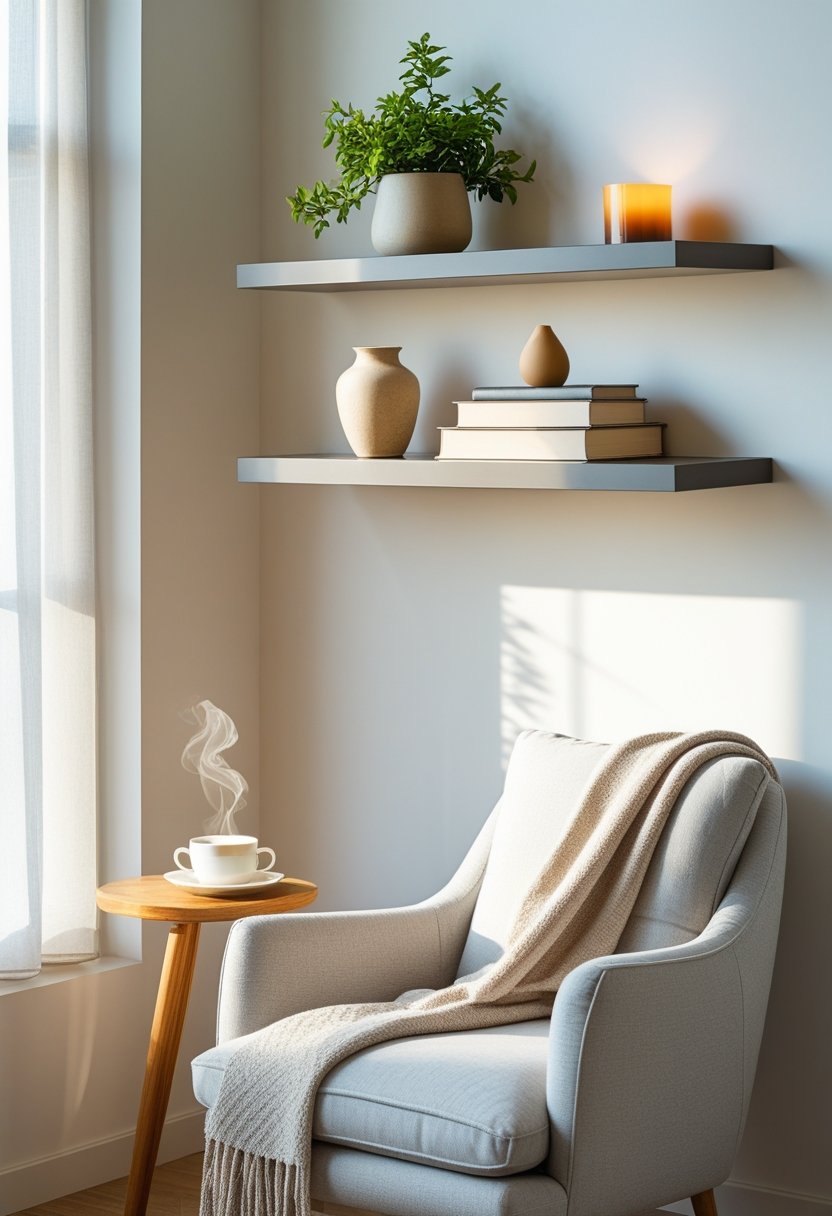
A cozy minimalist home balances simplicity with warmth through natural materials, layered lighting, and thoughtful decor choices. Each room can be enhanced by focusing on key elements that maintain function while adding comfort and a personal touch.
Minimalist Living Room Design
In a minimalist living room, neutral tones like beige, soft gray, or warm white create a calm backdrop. The furniture should be sleek but comfortable, favoring pieces with clean lines and natural wood finishes.
Layered lighting is essential. Combining warm overhead lights with floor lamps or table lamps highlights textures and creates a cozy atmosphere. Incorporate woven baskets or soft textiles like wool or linen rugs for texture.
A carefully chosen focal point, such as a floating wooden shelf with a few potted plants and simple decor items, ties the space together without clutter. This keeps the living room functional, inviting, and visually balanced.
Serene Minimalist Bedroom Corners
A minimalist bedroom corner focuses on rest and relaxation through simplicity and softness. Use a muted, warm palette with light woods or rattan elements to introduce organic warmth.
Add a soft reading nook with a boucle accent chair and a subtle floor lamp with warm light. Keep decor minimal but meaningful—such as a single piece of artwork or a few green plants—avoiding clutter.
Textiles play a vital role: layered bedding and a wool or jute rug add tactile comfort. The goal is to craft a serene retreat that feels cozy yet uncluttered, fostering restful energy.
Minimalist Kitchen Touches
In the minimalist kitchen, open shelves made from warm wood help keep the space airy and organized. Using simple, clean white cabinetry combined with wooden accents supports a modern yet inviting look.
Functional décor includes ceramic or glass containers, potted herbs, and woven baskets for practical storage while maintaining natural texture. Lighting should be soft but sufficient, with under-cabinet LED strips or pendant lights in warm tones.
A clear counter space enhances practicality, while a few well-chosen decorative items create a calm, uncluttered vibe that blends style and simplicity effectively.
Adapting Your Minimalist Sanctuary for Every Season

Seasonal changes call for subtle adjustments to maintain comfort and style in a minimalist home. This includes incorporating different textures, updating natural elements, and coordinating lighting and color tones to match the time of year.
Layering Textures for Seasonal Warmth
Adding varied textures brings depth and warmth to minimalist spaces without clutter. In cooler months, layering soft wool throws, linen cushions, and woven rugs made from natural fibers like jute or cotton enhances comfort.
Warm wooden surfaces and tactile ceramic accessories can complement the smoothness of white floating shelves, creating a balanced look that feels inviting yet sleek. These materials maintain the minimalist ethos by focusing on quality over quantity while adapting to the need for coziness.
Using neutral tones in these layers keeps the space calming and aligned with Scandinavian simplicity.
Refreshing Your Decor for Spring and Summer
Spring and summer call for lighter, airier decor to reflect the seasons’ brightness. Swapping out heavier textiles for lightweight linens or cotton blends helps create an open, breathable atmosphere.
Bringing in fresh greenery, such as potted herbs or trailing plants, enhances the biophilic design by connecting the indoors with nature. Choose plants that thrive in natural light and require minimal maintenance to keep the setup simple and practical.
Switch to softer, golden-hued lighting or natural daylight where possible to highlight the warm wooden textures and white shelves without overpowering the space.
Transitioning Into Autumn and Winter
As days grow shorter and temperatures drop, transitioning the space with richer natural materials and muted color palettes is key. Replace light fabrics with thicker wools or fleece in warm earth tones like ochre, deep green, or charcoal gray.
Incorporate autumnal accessories such as dried flowers or wood accents that echo the changing season. Layering ambient lighting with candles or soft LED fixtures adds warmth and comfort, countering the cooler outdoor climate.
Keeping the minimalist wall shelf decor simple with just a few well-chosen items allows the home to feel seasonally appropriate without feeling crowded or busy.

Ana Luisa
Explore in-depth biographies, net worth insights, and exclusive updates on your favorite singers at Trionua.com. Discover the journeys, achievements, and latest news about music’s biggest stars.

